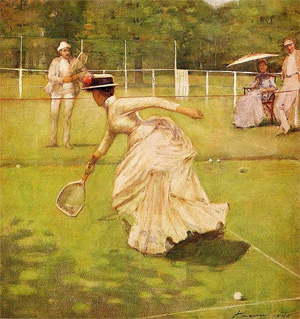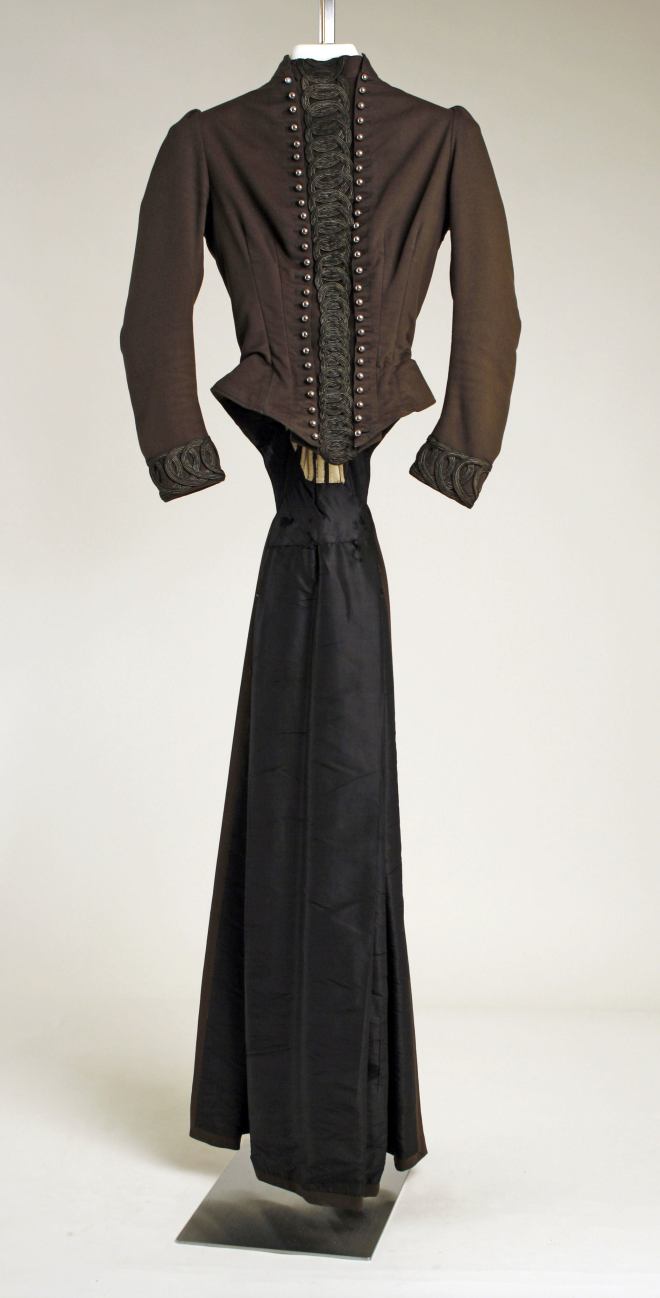During the 1880s, sportswear became increasingly prevalent in women’s wardrobes as women increasingly spent more time outside the house and participated in various sporting activities. Cycling, tennis, and yachting were some of the more popular outdoor pastimes and while these started with women from affluent backgrounds, they gradually began to trickle down to the middle class.
As mentioned in an earlier post on John Redfern/Redfern & Sons, one of Redfern’s specialties was designing sports clothes and in particular, yachting dresses. Below is a plate from the July 31, 1887 issue of Harper’s Bazar:
Moving from left to right, each dress is described:
Fig. 1- This youthful gown has a red serge Eton jacket, a white cloth waistcoat with gilt cord and buttons, and navy blue serge skirt with white cloth panels and a short apron. Gilt anchors of cord are on the white cuffs of the red jacket and anchors trim the skirt on the hips and at the foot. The red straw sailor hat has a white ribbon band and bow.
Fig. 2- This pretty dress for either tennis or yachting is of blue and white stripped serge or flannel, with a blouse-waist of dark blue India silk or of surah. The jacket is of simple sacque shape, quite short behind, pointed in front, open from the collar down. The lower skirt has wide pleats, and the apron is deep and pointed. White cloth sailor hat with blue ribbon band.
Fig. 3- This costume has a blue jacket, skirt, and cap, decorated with red anchors. The draped bodice is of white washing silk or of white wool, with a gilt belt and gilt buttons. The jacket is short and adjusted behind, but falls open in front in square tabs; it is lined throughout with red silk, which shows at the top when turned back.
Fig. 4- This gown is of white wool, with surplice belted waist and plastron, belt, sash, and borders of blue and white striped wool or of washing silk. It can also be made of navy blue with jersey webbing of blue and white stripes. Quite dressy toilettes of white nuns’ veiling or of challi are made by this simple design and trimmed with Pompadour-stripped silks, or those with Roman stripes or metallic stripes, or else with the silk tennis scarfs that have tennis bats, stripes, etc. wrought in them.
The first three dresses feature a jacket over a shirtwaist (or “blouse-waist”), a look that was characteristic of the 1880s and 1890s. The fourth dress is somewhat more formal and features a plastron bodice. Combined with masculine hats such as boaters or flat cap, the first three dresses give an air of casualness and ease of movement that is tempered somewhat by the bustled skirts. The fourth dress stands in contrast to the first three.
Of all the sporting activities women participated in, tennis was probably one of the most strenuous, requiring freedom of movement. Naturally, dress styles followed and here is just one example:
While the above dress gives an air of vigor and free movement, it is still anchored to the 1880s in that the bustle still remains, thought to be an aid to stabilizing the frail female body. At the same time however, we do see a shortening of the skirt to ease movement and a minimum of trim.
Below is a tennis dress that is believed to date from 1880 through 1890:
 The 1880s version of sportswear was not the most practical by today’s standards but it was a start and it represented a major departure for women in the way they lived their lives. No longer did life center around the home but it now included other spheres of life. During the 1890s, sportswear was to evolve even further and especially with the growth of cycling and this trend would ultimately combine with other trends that propelled women into playing a greater role in public life, thus giving rise to the “New Woman.”
The 1880s version of sportswear was not the most practical by today’s standards but it was a start and it represented a major departure for women in the way they lived their lives. No longer did life center around the home but it now included other spheres of life. During the 1890s, sportswear was to evolve even further and especially with the growth of cycling and this trend would ultimately combine with other trends that propelled women into playing a greater role in public life, thus giving rise to the “New Woman.”
This post only gives a taste of what was to come later in the 1890s but it’s interesting to see how it got its start. What is especially jarring to modern eyes is how the bustle still remained a style element even though it hindered the body’s free movement. But nevertheless, the die was cast and there were going to be changes in the role of women, changes that are still playing out to this day.






























































